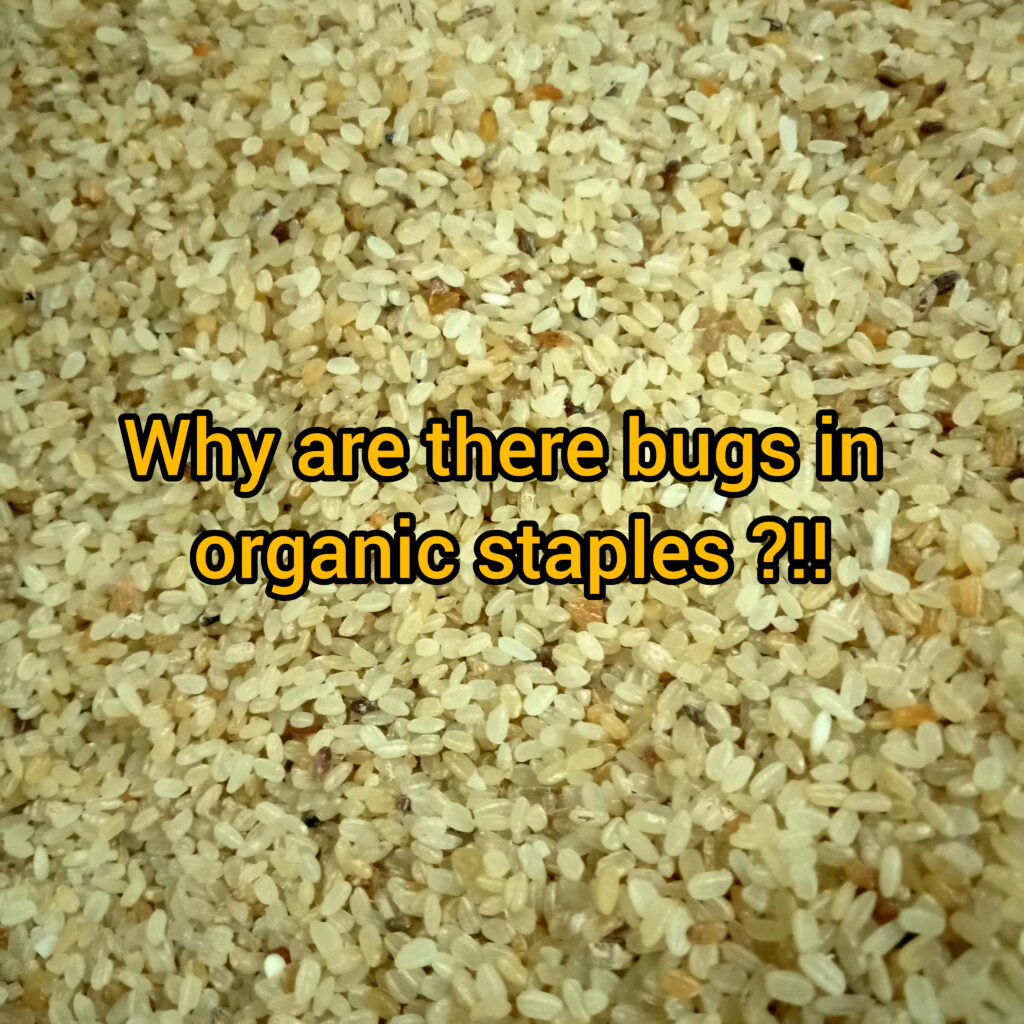Blog
Why are there bugs in Organic staple?!!

This is not something you expect after paying for organic produce, but to be honest this is actually something you should expect from time to time when you order organic groceries. Before these creatures fume us up, let us delve a little deeper into understanding this issue.
Most common bugs found in staples like pulses and cereals are either weevils or beetles although there are a few moths too. In agricultural science terms these are called storage pests. It has been estimated that between one quarter and one third of the world grain crop is lost each year during storage, and these pests are not just limited to organic produce.
Storage pests have been a problem since our hunter gatherer forefathers had a career shift to agriculture and than moved to real estate. We as a species have been trying to battle them from the time we stored our grains in earthenware vessels sealed with clay till today where we have foolproof spices that ward the pests and vacuum packaging. I am pretty sure the President’s organic pantry has a few bugs and there is nothing the Chief of staff can do about it.
So how do these bugs get in the first place, if we study their life cycles, most of these insects lay their eggs on the grain ( some do in cracks and under the sheath) in the farm just before harvest. Even after all the grading, processing and refining the eggs are tiny enough to get through. And once they find the right temperature to hatch in your pantry the party is on.
Why do they find the grains so attractive that they drill a hole and et it up..? The storage pests use the bran and protein of the grain to multiply in it’s population. Have shared a detailed post in this regard earlier.
So why is storage pest presence lower in store bought grains or pulses ?Just as commercial agriculture uses a lot of harmful pesticides, commercial storage of grains uses a myriad of harmful pesticides and fungicides that are sprayed to ward the pest and the grains are clean, spotless! All these storage processes may reduce the incidence of pests but leave behind traces of potentially harmful chemicals.. Where the chemicals wear off after a certain time so multiple applications are done increasing the amount of harmful residue, but still these produce do get affected with bugs eventually and are commonly converted to flours etc and passed on.
So what can be done about this ?
At our end we sort any pest infested staples before and after processing, but when the eggs have not hatched and there is no visible damage these will be delivered as nor the farmer or us have any way of checking this. Most cereals, pulses and flours are delivered in a week or two once they reach us. As a policy we don’t use any chemicals to store the produce, however we do store them with neem leaves, red chillies/ Indian bay leaves which is a natural pest repellent..
Here a few things you can do to avoid pests and store organic grains, pulses and nuts for a long time
1. Sun drying : Once you receive the produce you can spread them thinly on a cotton cloth or mat and keep it under direct sunlight for a few hours. Any eggs will be rendered unhatchable and even adult bugs will be killed. This will also reduce moisture content of the produce making them less susceptible to other microbial attacks.
2. Storing in the Fridge : Staples stored in the fridge stay pest free for longer as the low temperature means the any eggs don’t get the chance to hatch.
3. Adding Natural Pest repellents : You can add Neem or Bay leaves, Cloves, red chillies to rice and other cereals and pulses. All of these have natural oils which repel pests and do not leave any residue or tinge the product. You can just remove them when using the nuts or grains.
4. Storing in Sealed containers : Always store individual items separately in containers with a very good airtight seal. Don’t leave the produce in cloth or paper or plastic packaging they came. Always thoroughly clean the container before refilling to kill any unhatched eggs.
5. Cleaning Pantries : Once in a while cleaning pantries and cupboards thoroughly will clear out any hidden pests and avoid cross infestation. You can remove all containers and vacuum the cupboards or dust and clean with a solution of lime juice diluted with water or bioenzyme..
Although these methods may look like another task in your already busy lives, its worth taking these precautions than to consume produce which has residues of harmful and banned insecticides..
Any other tips and tricks you have used to keep staples pest free, please share with us and we will be glad to publish..
MJ 🌾
These storage insects don’t contaminate your food and health, pesticides do!
